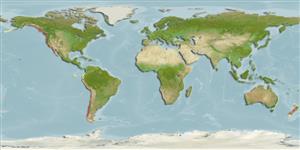Environment: milieu / Zona climática / intervalo de profundidade / distribution range
Ecologia
marinhas demersal; intervalo de profundidade 0 - 49 m (Ref. 2850). Subtropical; 60°N -
Eastern Pacific: Kodiak Island, Alaska to Point San Carlos, central Baja California, Mexico.
Tamanho / Peso / Idade
Maturidade: Lm ? range ? - ? cm
Max length : 25.0 cm TL macho/indeterminado; (Ref. 4925); idade máx. registrada: 8 anos (Ref. 56049)
Descrição suscinta
Chaves de identificação | Morfologia | Morfometria
Espinhos dorsais (total) : 16; Raios dorsais (total) : 14 - 16; Espinhos anais: 3 - 4; Raios anais : 12 - 13; Vértebras: 36 - 39. Dorsal rayed part higher than spinous part. Caudal gently rounded. Anal notched between spinous and rayed parts, well incised (Ref. 6885). Head with scales; one fleshy cirrus above each eye and a pair on the occiput; gill membranes joined, free of isthmus. Body with 7 dark vertical bands. Pelvic fin of moderate length, not reaching the anus (Ref. 48751).
Body shape (shape guide): fusiform / normal.
Found in rocky areas, from the intertidal to 49 m (Ref. 2850). Sleeps on the oral disc, leaving the anemone (Urticina lofotensis) by day but returning every night (Ref. 45560). Commonly encountered hovering motionless by divers (Ref. 2850). Feeds on crustaceans, polychaetes, small mollusks and bryozoans (Ref. 4930). Neither anterolateral glandular grooves nor venom gland is present (Ref. 57406).
Eschmeyer, W.N., E.S. Herald and H. Hammann, 1983. A field guide to Pacific coast fishes of North America. Boston (MA, USA): Houghton Mifflin Company. xii+336 p. (Ref. 2850)
Status na Lista Vermelha da UICN (Ref. 130435: Version 2025-1)
Uso pelos humanos
Ferramentas
Relatórios especiais
Baixar XML
Fontes da internet
Estimates based on models
Preferred temperature (Ref.
123201): 7.9 - 13.8, mean 10.4 °C (based on 128 cells).
Índice de diversidade filogenética (Ref.
82804): PD
50 = 1.1250 [Uniqueness, from 0.5 = low to 2.0 = high].
Bayesian length-weight: a=0.01122 (0.00514 - 0.02450), b=3.04 (2.87 - 3.21), in cm total length, based on all LWR estimates for this body shape (Ref.
93245).
Nível Trófico (Ref.
69278): 3.4 ±0.42 se; based on food items.
Resiliência (Ref.
120179): médio(a), tempo mínimo de duplicação da população 1,4 - 4,4 anos (tm=2.5; tmax=8; Fec=112,000).
Fishing Vulnerability (Ref.
59153): Low vulnerability (15 of 100).
🛈
Nutrients (Ref.
124155): Calcium = 139 [53, 289] mg/100g; Iron = 1.29 [0.59, 3.09] mg/100g; Protein = 18.5 [16.5, 20.5] %; Omega3 = 0.513 [0.242, 1.348] g/100g; Selenium = 21.1 [11.2, 53.5] μg/100g; VitaminA = 18.4 [6.6, 50.9] μg/100g; Zinc = 0.95 [0.65, 1.46] mg/100g (wet weight);
